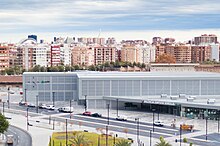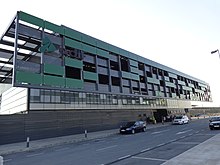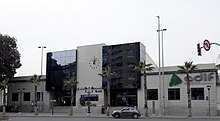Madrid – Levante high-speed line
| Madrid – Levante high-speed line | |||||||||||||||||||||||||||||||||||||||||||||||||||||||||||||||||||||||||||||||||||||||||||||||||||||||||||||||||||||||||||||||||||||||||||||||||||||||||||||||||||||||||||||||||||||||||||||||||||||||||||||||||||||||||||||||||||||||||||||||||||||||||||||||||||||||||||||||||||||||||||||||||||||||||||||||||||||||||||||||||||||||||||||||||||||||||||||||||
|---|---|---|---|---|---|---|---|---|---|---|---|---|---|---|---|---|---|---|---|---|---|---|---|---|---|---|---|---|---|---|---|---|---|---|---|---|---|---|---|---|---|---|---|---|---|---|---|---|---|---|---|---|---|---|---|---|---|---|---|---|---|---|---|---|---|---|---|---|---|---|---|---|---|---|---|---|---|---|---|---|---|---|---|---|---|---|---|---|---|---|---|---|---|---|---|---|---|---|---|---|---|---|---|---|---|---|---|---|---|---|---|---|---|---|---|---|---|---|---|---|---|---|---|---|---|---|---|---|---|---|---|---|---|---|---|---|---|---|---|---|---|---|---|---|---|---|---|---|---|---|---|---|---|---|---|---|---|---|---|---|---|---|---|---|---|---|---|---|---|---|---|---|---|---|---|---|---|---|---|---|---|---|---|---|---|---|---|---|---|---|---|---|---|---|---|---|---|---|---|---|---|---|---|---|---|---|---|---|---|---|---|---|---|---|---|---|---|---|---|---|---|---|---|---|---|---|---|---|---|---|---|---|---|---|---|---|---|---|---|---|---|---|---|---|---|---|---|---|---|---|---|---|---|---|---|---|---|---|---|---|---|---|---|---|---|---|---|---|---|---|---|---|---|---|---|---|---|---|---|---|---|---|---|---|---|---|---|---|---|---|---|---|---|---|---|---|---|---|---|---|---|---|---|---|---|---|---|---|---|---|---|---|---|---|---|---|---|---|---|---|---|---|---|---|---|---|---|---|---|---|---|---|---|---|---|---|---|---|---|---|---|---|---|---|---|---|---|---|---|---|---|---|---|
|
Class 730 double traction on the road between Cuenca and Madrid.
| |||||||||||||||||||||||||||||||||||||||||||||||||||||||||||||||||||||||||||||||||||||||||||||||||||||||||||||||||||||||||||||||||||||||||||||||||||||||||||||||||||||||||||||||||||||||||||||||||||||||||||||||||||||||||||||||||||||||||||||||||||||||||||||||||||||||||||||||||||||||||||||||||||||||||||||||||||||||||||||||||||||||||||||||||||||||||||||||||
| Route number : | 13 | ||||||||||||||||||||||||||||||||||||||||||||||||||||||||||||||||||||||||||||||||||||||||||||||||||||||||||||||||||||||||||||||||||||||||||||||||||||||||||||||||||||||||||||||||||||||||||||||||||||||||||||||||||||||||||||||||||||||||||||||||||||||||||||||||||||||||||||||||||||||||||||||||||||||||||||||||||||||||||||||||||||||||||||||||||||||||||||||||
| Route length: | total including planning: 955 km in operation: 603 km |
||||||||||||||||||||||||||||||||||||||||||||||||||||||||||||||||||||||||||||||||||||||||||||||||||||||||||||||||||||||||||||||||||||||||||||||||||||||||||||||||||||||||||||||||||||||||||||||||||||||||||||||||||||||||||||||||||||||||||||||||||||||||||||||||||||||||||||||||||||||||||||||||||||||||||||||||||||||||||||||||||||||||||||||||||||||||||||||||
| Gauge : | 1435 mm ( standard gauge ) | ||||||||||||||||||||||||||||||||||||||||||||||||||||||||||||||||||||||||||||||||||||||||||||||||||||||||||||||||||||||||||||||||||||||||||||||||||||||||||||||||||||||||||||||||||||||||||||||||||||||||||||||||||||||||||||||||||||||||||||||||||||||||||||||||||||||||||||||||||||||||||||||||||||||||||||||||||||||||||||||||||||||||||||||||||||||||||||||||
| Power system : | 25 kV 50 Hz ~ | ||||||||||||||||||||||||||||||||||||||||||||||||||||||||||||||||||||||||||||||||||||||||||||||||||||||||||||||||||||||||||||||||||||||||||||||||||||||||||||||||||||||||||||||||||||||||||||||||||||||||||||||||||||||||||||||||||||||||||||||||||||||||||||||||||||||||||||||||||||||||||||||||||||||||||||||||||||||||||||||||||||||||||||||||||||||||||||||||
| Maximum slope : | 30 ‰ | ||||||||||||||||||||||||||||||||||||||||||||||||||||||||||||||||||||||||||||||||||||||||||||||||||||||||||||||||||||||||||||||||||||||||||||||||||||||||||||||||||||||||||||||||||||||||||||||||||||||||||||||||||||||||||||||||||||||||||||||||||||||||||||||||||||||||||||||||||||||||||||||||||||||||||||||||||||||||||||||||||||||||||||||||||||||||||||||||
| Top speed: | 300 km / h | ||||||||||||||||||||||||||||||||||||||||||||||||||||||||||||||||||||||||||||||||||||||||||||||||||||||||||||||||||||||||||||||||||||||||||||||||||||||||||||||||||||||||||||||||||||||||||||||||||||||||||||||||||||||||||||||||||||||||||||||||||||||||||||||||||||||||||||||||||||||||||||||||||||||||||||||||||||||||||||||||||||||||||||||||||||||||||||||||
| Dual track : | (continuously on the built routes) | ||||||||||||||||||||||||||||||||||||||||||||||||||||||||||||||||||||||||||||||||||||||||||||||||||||||||||||||||||||||||||||||||||||||||||||||||||||||||||||||||||||||||||||||||||||||||||||||||||||||||||||||||||||||||||||||||||||||||||||||||||||||||||||||||||||||||||||||||||||||||||||||||||||||||||||||||||||||||||||||||||||||||||||||||||||||||||||||||
|
|||||||||||||||||||||||||||||||||||||||||||||||||||||||||||||||||||||||||||||||||||||||||||||||||||||||||||||||||||||||||||||||||||||||||||||||||||||||||||||||||||||||||||||||||||||||||||||||||||||||||||||||||||||||||||||||||||||||||||||||||||||||||||||||||||||||||||||||||||||||||||||||||||||||||||||||||||||||||||||||||||||||||||||||||||||||||||||||||
The high-speed line Madrid – Levante , Spanish Línea Levante , with its full name high-speed line Madrid– Castilla La Mancha – Valencian Community – Region Murcia , Spanish Línea Madrid - Castilla La Mancha - Comunidad Valenciana - Región de Murcia , is a Spanish railway - high-speed line , which the Capital Madrid connects with the east and south-east of Castile-La Mancha , Valencian Community and Murcia . The standard - gauge high - speed lines from Madrid are supplemented by broad-gauge railway lines to form a route network that is partly shared by the railway line along the Mediterranean . Of the planned 955 kilometers of standard gauge lines, 603 kilometers have been built. The costs for the entire project are estimated at 12.410 billion euros (as of the end of 2017).
history
Even before the normal-gauge high-speed line was built, parts of the broad-gauge line Madrid - Alcázar de San Juan - Albacete - La Encina - Xàtiva - Valencia were expanded. In 1997, the La Encina – Xàtiva section was first prepared for 220 km / h, followed by the Alcázar de San Juan – Albacete – La Encina section for 200 km / h in 2006.
The construction of the standard-gauge high-speed line was decided on September 17, 1999 by the Spanish government. In 2010 the section Madrid - Albacete y Madrid - Valencia and in 2013 the extension from Albacete to Alicante went into operation. The next completed sections are Monforte del Cid - Murcia and the three- rail track Valencia - Castéllon .
Route sections
Madrid Chamartín – Torrejón de Velasco
The zero point of the route mileage is in Madrid Chamartín train station in the northern part of Madrid. This is currently not yet connected to the Madrid – Levante high-speed line.
So far, trains on the Madrid – Levante high-speed line have used Madrid Atocha station in the south of Madrid. The trains use the high-speed line to Seville as far as the Torrejón de Velasco junction .
The tunnel for the high-speed trains between Madrid Chamartín station and the underground station in Madrid Atocha will go into operation in 2018 at the earliest, as will the second double lane running parallel to the Madrid – Seville high-speed line to the Torrejón de Velasco junction . The construction costs for this section of the route amount to 935 million euros.
Madrid – Valencia / Albacete
The first 438 kilometer section of the Madrid – Levante high-speed line opened on December 19, 2010. It connects Valencia and Albacete with the Puerta de Atocha train station in Madrid. The line branches off the high-speed line Madrid – Seville at Torrejón de Velasco and leads via Cuenca to the Motilla del Palancar junction , where the line splits into two branches. One branch route leads via Requena-Utiel to Valencia, the other leads to Albacete. The construction costs for this section of the route amounted to 6 billion euros.


The travel time from Madrid to Valencia was reduced from just under four to one and a half hours, and the travel time between the Spanish capital and Albacete was also reduced to around 90 minutes. The route is designed for 350 km / h, but is currently only driven at 300 km / h.
The Motilla del Palancar – Valencia section is particularly rich in engineering structures. Particularly noteworthy is the imposing bridge over the Contreras reservoir , the main arch of which with a span of 261 meters holds the record for the largest span for a concrete arch bridge in the European railway network. Shortly thereafter, the route leads over the 830 meter long and 90 meter high Isthmus Viaduct. The Cabrera tunnel, which is over 7 kilometers long, should also be mentioned. It was excavated with a tunnel boring machine , which excavated over 90 meters in one day and thereby broke the world record for the fastest advance.
With the opening of the first section of the route, direct trains Toledo – Cuenca – Albacete were offered, but these were discontinued on July 1, 2011 because they were only used by an average of nine passengers per day. The connecting curve at Valdemoro is therefore currently not used in timetable operation.
Valencia Central and Valencia City Tunnel
The Valencia Central underground station has been planned since 2003 and would be connected to the network with a 9 km tunnel. The tunnel would significantly shorten the route along the Mediterranean Sea and make the detour via Valencia Cabañal superfluous. Some infrastructure adjustments at the southern entrance have already been carried out, but the underground station project has been revised and postponed again and again due to the high costs. In 2017, the funds were approved to work out the fifth project for the underground station. The costs are estimated at 538.7 million euros.
Albacete – Alicante
The second section, the 171.5-kilometer section from Albacete to Alicante, was opened on June 18, 2013. The construction costs for this section of the route amounted to 1.92 billion euros.
This section of the route was built using existing broad-gauge sections that had already been expanded for 200 km / h. These were the straightening of the route at Chinchilla , at Villar de Chinchilla and at Alpera.
The new Villena train station, the 1,481 m long viaduct over the Vinalopó - the longest of the whole route and the almost three kilometer long tunnel through the Barrancadas are also located in this section . At Monforte del Cid the junction to Murcia was prepared. In Alicante, the line will run underground for the last two kilometers and end in a newly built underground station with four standard gauge tracks and two broad gauge tracks.
Monforte del Cid – Murcia
This third section branches off the route to Alicante at Monforte del Cid and leads via Elche to Murcia. The standard-gauge line is single -track from Orihuela -Miguel Hernández. The track of the single-lane broad-gauge line coming from Alicante is run on the same track body . The last 10 kilometers of the introduction to Murcia are provisionally guided on a single-lane three-rail track until the lowering of the line in the city is completed.
The opening of the section is planned for the second half of 2018. Standard gauge direct trains to Madrid with a stop in Elche are to be offered. The broad-gauge Murcia – Alicante line will also operate express trains from Renfe's Avant range, which will cover the route in 25 minutes with stops in Elche and Orihuela and reach a top speed of 250 km / h.
Albacete-Almansa-La Encina-Xátiva
This section of the route was the oldest developed for high-speed traffic. The La Encina– Xàtiva line was rebuilt and from 1997 onwards, 220 km / h, the Alcázar de San Juan – La Encina route after straightening from 2006 at 200 km / h. During the construction of the standard gauge line Albacete – Alicante, the straightened route of the broad gauge line Albacete – La Encina was used and the broad gauge line was relocated back to the old, non-straightened route. That is why she has only been between Albacete and La Encina at 160 since 2013 km / h passable.
The La Encina – Xátiva section is still at 220 km / h passable, but can only be used by broad-gauge trains on the railway line along the Mediterranean Sea or by those that run from Albacete over the old route. There is no direct connection to the standard gauge line in La Encina. In 2017, a single-track broad-gauge line between La Encina and Xátiva was under construction. After completion of this route, the 220 km / h designed broad-gauge line will be converted to standard gauge and connected to the existing standard gauge line in La Encina.
Xátiva – Silla
A double-track high-speed line designed for 300 km / h was built parallel to the existing broad-gauge line on the 59 km section. The tracks have already been laid, and the catenary construction should be completed by 2019. Commissioning should take place in 2020. From Silla, the trains will use the new south access that has already been built and which has already been built in connection with the preparatory work for the underground station in Valencia.
Valencia – Castellón de la Plana
The broad-gauge line Valencia – Castellón was already in 2004 with 200 km / h passable. In recent years, a third rail for standard gauge has been built into a track on the section , but it can only be driven at 160 km / h. The test drives took place in 2017 and the opening is imminent. Starting in 2019, a new route is to be built that a double-track standard gauge line for 300 km / h top speed.
Monforte del Cid – Murcia
The 61.7 kilometer section to Murcia is under construction. The tracks were laid at the end of 2017. The line runs double-track from the Murcia junction at Monforte del Cid to Orihuela-Miguel Hernandez station, which is only used as an alternate and overtaking station for the high-speed line. From there, a normal psur track and a broad gauge track coming from Alicante continue on the double-track track. From El Reguerón, the line runs on a single three-rail track to Murcia. This is a temporary measure during the construction of the access tunnel and the new underground station in Murcia.
Murcia – Cartagena
The existing route from Murcia to Cartagena is to be electrified and provided with a three-rail track so that standard-gauge trains can run. For the direct connection from Alicante and Madrid to Cartagena, an approximately four-kilometer-long connecting curve is planned between the high-speed line and the existing broad-gauge Chinchilla – Cartagena line so that the trains don't have to turn heads in Murcia.
In Cartagena, the construction of an underground entry into the city with a 760 m long tunnel under the existing route is planned, which is to be used by the normal and broad gauge trains. While the broad gauge trains reach the existing above-ground station via a ramp, a new double-track underground station with 400 m long platforms is planned for the high-speed trains.
Later the construction of a standard-gauge high-speed line for 250 km / h is planned. A two-kilometer tunnel is to lead under the Sierra de Altaona. Construction costs of 500 million euros are expected.
Route overview
| status | route | Top speed | length | Installation | Gauge | Power system | Train control | building-costs |
|---|---|---|---|---|---|---|---|---|
| Under construction |
Madrid Chamartín - Torrejón de Velasco |
300 km / h tunnel: 120 km / h |
35 km | Track systems completed at the end of 2018 | 1435 mm | 25 kV 50 Hz | ETCS level 2 | 935 million euros |
| In operation |
Torrejón de Velasco - Motilla del Palancar |
300 km / h | 223.6 km | 2010 | 1435 mm | 25 kV 50 Hz | ETCS level 2 | 6 billion euros |
| In operation | Motilla del Palancar - Valencia | 300 km / h | 139 km | 2010 | 1435 mm | 25 kV 50 Hz | ETCS level 2 | |
| In operation | Motilla del Palancar - Albacete | 300 km / h | 62.8 km | 2010 | 1435 mm | 25 kV 50 Hz | ETCS level 2 | |
| Planned | Valencia Central Railway Station and Valencia City Tunnel | 9 km | Credit spoken for revising the preliminary project | 1435 mm | 25 kV 50 Hz | 539 million euros | ||
| In operation | Albacete– Alicante | 300 km / h | 165 km | 2013 | 1435 mm | 25 kV 50 Hz | ETCS 2 | 1.9 billion euros |
| In operation | Albacete - Almansa - La Encina - Xátiva | 220 km / h only La Encina – Xátiva, rest of the route: 160 km / h |
138.2 km | 1997 | 1668 mm La Encina – Xátiva: Preparations for re-gauging to 1435 mm under construction |
3 kV = | EBICAB | |
| Under construction | Xátiva - Silla | 300 km / h | 59 km | 2020 Track systems completed, electrification in progress |
1435 mm | 25 kV 50 Hz | ||
| Planned | Valencia - Castellón de la Plana |
350 km / h | 62 km | Start of construction 2019 | 1435 mm | 25 kV 50 Hz | 1.2 billion euros | |
| Under construction | Monforte del Cid - Murcia | 220 km / h | 61.7 km | Track systems completed at the end of 2018 | 1435 mm | 25 kV 50 Hz | ||
| Planned | Murcia– Cartagena | 45.3 km | Start of construction 2019 (three-rail track) | 1435 mm / 1668 mm three-rail track | 25 kV 50 Hz |
Web links
Individual evidence
- ↑ Network Statement 2017. (PDF) Adif Alta Velocidad, accessed on December 5, 2017 (English).
- ↑ Línea de FC de alta velocidad de "Madrid a Levante y Sureste" y sus Estaciones en Google Earth. euroferroviarios.net, accessed on December 8, 2017 (Spanish, Google Earth file with web links to the individual operating locations ).
- ↑ a b c d e f g Línea Levante. Adif Alta Velocidad, accessed December 9, 2017 (Spanish).
- ↑ a b Línea 300 de Adif de Madrid Chamartín a Valencia Estació del Nord. In: Ferropedia. Retrieved December 15, 2017 (Spanish).
- ↑ Más de dos Decadas reclamando el AVE entre Valencia y la capital de España. Las Provincias, December 18, 2010, accessed December 16, 2017 .
- ↑ Madrid-Chamartín (Est.). EuroFerroviarios, accessed December 8, 2017 (Spanish).
- ↑ Los fallos de seguridad retrasan las cinco inauguraciones del AVE previstas para 2018. In: El Independiente. November 22, 2017. Retrieved December 8, 2017 .
- ↑ a b Las obras de duplicación de vía entre Atocha y Torrejón de Velasco finalizarán en 2018. Tele Madrid, 2 September 2017, accessed on 10 December 2017 .
- ↑ a b c d e f g h i Maps of Adif-Alta Velocidad Managed Network. (PDF) In: Network Statement 2017. Adif Alta Velocidad, accessed on December 5, 2017 (English).
- ^ Túnel de la Cabrera. Adif Alta Velocidad, Retrieved December 14, 2017 (Spanish).
- ↑ RENFE elimina el AVE entre Toledo Albacete y porque solo lleva 9 Pasajeros. In: El País. June 28, 2011, Retrieved November 26, 2017 (Spanish).
- ↑ Laura Ballester: Fomento dilata la Estación Central de València al encargar un quinto proyecto. Retrieved December 9, 2017 .
- ^ LAV Madrid - Alicante. In: Ferropedia. Retrieved December 16, 2017 (Spanish).
- ↑ Route diagram Monforte del Cid – Murcia. Accessed December 7, 2017 .
- ↑ Fomento unirá Alicante y Murcia en 25 minutos con un tren con paradas en Elche y Orihuela. diarioinformacion, accessed December 7, 2017 .
- ↑ Valencia-Xativa. In: El Corredor Mediterráneo. Retrieved December 16, 2017 (European Spanish).
- ↑ Paula Varella: ADIF ASEGURA que la llegada del AVE there a Castellón inminente. In: Cadena SER. November 17, 2017. Retrieved December 16, 2017 .
- ↑ a b El tramo Valencia-Castellón tendrá plataforma de ancho internacional. In: La Vanguardia. July 5, 2017, Retrieved December 10, 2017 (Spanish).
- ↑ Adif Alta Velocidad: Ramal de conexión entre la línea de alta velocidad Monforte del Cid - Murcia y la línea Chinchilla - Cartagena. In: Plataforma de Contratación del Sector Público. Retrieved December 16, 2017 .
- ↑ Portavoz. Agencia de publicidad: Murcia Alta Velocidad - Cartagena Alta Velocidad. November 21, 2008, Retrieved December 16, 2017 (Spanish).
- ↑ Fomento adaptará las vías para tener AVE cuanto antes y deja para otra fase la línea definitiva . In: La Verdad . June 28, 2017 ( laverdad.es [accessed December 16, 2017]).
- ↑ Tramo AVE Cartagena-Murcia. In: La Verdad. Retrieved December 16, 2017 .
- ↑ Laura Ballester: Fomento dilata la Estación Central de València al encargar un quinto proyecto. In: Levante-EMC. October 5, 2017, accessed December 10, 2017 .
- ^ A b c Maps of Adif Managed Network. (PDF) In: Network Statement 2017. Adif, accessed on December 5, 2017 (English).
- ↑ Francisco Diaz Pardo: Aclaraciones Ferroviarias II: Nudo de la Encina-Xátiva-Valencia. (No longer available online.) August 23, 2017, archived from the original on December 13, 2017 ; accessed December 10, 2017 . Info: The archive link was inserted automatically and has not yet been checked. Please check the original and archive link according to the instructions and then remove this notice.
- ^ T.10 València - Xàtiva. In: El Corredor Mediterráneo. Retrieved December 10, 2017 (Spanish).
- ↑ Manuel Romero: AVE a Murcia, ¿es lo mejor que nos ha pasado? In: Diario Informacion. May 4, 2017, Retrieved December 10, 2017 (Spanish).
- ↑ Fomento adaptará las vías para tener AVE cuanto antes y deja para otra fase la línea definitiva. In: La Verdad. June 28, 2017, Retrieved December 10, 2017 (Spanish).



